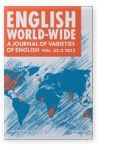Vol. 33:3 (2012) ► pp.264–291
Performing Bombay and displaying stances
Stylized Indian English in fiction
This article examines novel characters’ use of creatively manufactured language in scripted dialogue, namely stylized Indian English (IndE) in Mistry’s 2002 novel, Family Matters. Broadly, stylized IndE speech contributes to the characters’ performance of localness, an evaluation that reviewers’ commentary of the novel corroborate. However, by drawing on Ochs’ model of direct and indirect indexicality to analyze the contextualized interactions of three groups of characters — Malpani, Shiv Sena drunk men, and Shiv Sena officers — I suggest that the characters more specifically combine stylized IndE features in different ways to display distinct stances. When assessed together with 1) sociohistorical details, 2) interlocutors’ comments, and 3) narratorial interruptions, such stylized IndE speech indirectly indexes and shapes their nuanced social roles in the novel as different types of villains. Stylized IndE features are thus indeterminate resources, braided together with other semiotic resources, and enabling the characters to perform fluid, contextually situated meanings.
Cited by (1)
Cited by 1 other publications
This list is based on CrossRef data as of 2 july 2024. Please note that it may not be complete. Sources presented here have been supplied by the respective publishers. Any errors therein should be reported to them.
